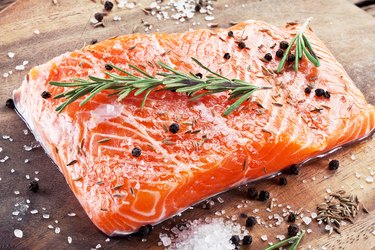
If you regularly eat salmon, you are probably well aware of the potential health effects of mercury. Typically, salmon is available as wild or farm raised. With choices available, you may wonder whether there are any differences between the two sources in terms of mercury content, especially if you are pregnant or of child-bearing age.
Mercury vs. Methylmercury
Video of the Day
An important distinction must be made between mercury and methylmercury. Mercury occurs naturally in the environment. Volcanoes and geologic deposits may contain naturally occurring mercury, according to the U.S. Geological Survey. Human-made sources include emissions from industry. These airborne emissions eventually fall to the earth's surface, contaminants soils and surface water. When mercury enters aquatic resources, such as the water bodies that host wild salmon, bacteria initiate a chemical reaction that converts mercury to its toxic form, methylmercury. This is the form of mercury in wild salmon that raises health concerns.
Video of the Day
Health Risks and Benefits
Wild salmon is an excellent source of omega-3 fatty acids. According to the Journal of the American Medical Association, omega-3 fatty acids can lower your blood pressure and reduce your risk of developing heart disease. However, you should monitor your wild salmon consumption if you are pregnant or nursing. Methylmercury found in wild salmon can accumulate in your body's tissues. It can have a negative impact on your baby's developing brain and nervous system.
Farm-Raised vs. Wild Salmon
When you buy salmon or eat out, it is important for you to know the source of the fish. A 2004 study in the journal Science found that farmed salmon had significantly higher levels of contaminants than their wild counterparts. The study went so far as to suggest that the health risks may outweigh the health benefits of eating salmon.
Geographic Location
Geographic location plays a key role on the mercury content of salmon, both wild and farm raised. The 2004 study identified European farm-raised salmon as having higher amounts of mercury. In terms of wild salmon, the U.S. Environmental Protection Agency, or EPA, recognizes similar variations with its Fish Advisories web page, which provides information about potential hazards of consuming wild salmon from certain areas. Variations may exist because of industry concentration, as well as geological factors.
Salmon Consumption Guidelines
The EPA and the Food and Drug Administration, or FDA, recognize salmon as a low-mercury fish. Yet, the current recommendations are to consume no more than 12 ounces of low-mercury fish a week. There is no distinction made between wild and farm-raised fish. A 2008 study published in Environmental Toxicology and Chemistry confirmed the efficacy of grouping wild and farm-raised salmon. The study found negligible differences in mercury content between the two sources from salmon in British Columbia, finding salmon a safe source of omega-3 fatty acids. Clearly, the best way to safely eat wild salmon is to adhere to the FDA guidelines and stay alert for local fish advisories.
- U.S. Geological Survey: Mercury in the Environment
- U.S. Environmental Protection Agency: Mercury—Health Effects
- U.S. Environmental Protection Agency: Advisories Where You Live
- U.S. Environmental Protection Agency: What You Need to Know about Mercury in Fish and Shellfish
- Health Castle: Farm Raised Salmon vs Wild Salmon